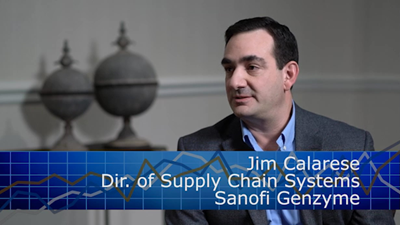This blog is part of a video interview series. Check out the video below as well as links to other supply chain practitioner and Kinaxis executive interviews.
Merging two companies is seldom easy, but it's even more difficult when their supply chains are highly dissimilar, says Jim Calarese, director of supply chain systems at Sanofi Genzyme.
The pharmaceutical company is the result of a takeover by Sanofi in 2001. The parent company’s supply chain was "plant-centric," Calarese says. By contrast, Genzyme's was completely end-to-end in nature. "Theirs was easier than ours." No pharmaceutical supply chain is without its challenges. Typically, supply chains are extended, lead times are long and a thicket of government regulations combine to present some steep challenges. Genzyme had diligently worked to have a total view of its supply chain as it developed and marketed drugs for rare diseases, multiple sclerosis, and oncology and immunology markets.

Following the acquisition, however, Genzyme had to acclimate to Sanofi’s processes and take on production of some products that originally had been developed by Sanofi. “As we gained more responsibilities, we had to integrate new products into our end-to-end view of things, we had to bring them into our sales and operations process, and to do that we use the RapidResponse tool from Kinaxis,” says Calarese. Getting S&OP right is crucial, since planning in the pharmaceutical world can extend several years out. “It takes a long time to get volumes and capacity up in this business,” he says. Spreadsheets were the go-to data gathering tool before implementation of RapidResponse. Visibility, hardly optimal with Excel, was the first thing gained with Kinaxis. “We started improving our forecast accuracy, which has driven a more stable finished goods plan.” Among other things, increased visibility means Sanofi Genzyme can notify partners if product delays are expected. “We can inform people ahead of time.” The pharmaceutical industry has a justly-deserved reputation for moving slowly. Noting that, Calarese says RapidResponse has been more evolutionary than revolutionary for supply chain planning. “Revolution, to me, is violent and quick. Our industry often is slow to move. Pharmaceuticals take a long time to develop and approve. The process piece has lagged the technology piece of it.” Having said that, Calarese says Sanofi Genzyme has mapped its future several years out. Pilots are in place to enhance attribute planning among other areas. “The future looks bright.”
Check out the other video interviews in this series:
- [Video] Xilinx: Fight the urge to be precise – How supply chain technology is helping Xilinx
- [Video] Keysight Technologies: Improving production planning efficiency
- [Video] Kinaxis – Revolutionizing supply chain planning
- [Video] Ford Motor Company: Creating global data standards with SCM software
- [Video] Long-term supply chain planning system vision and strategy
- [Video] Adapting supply chains to the digital phase of business
- [Video] Supply chain centers of excellence and customer success
- [Video] Roland DG: Transforming its sales and operations planning process
- [Video] Digital Technology and Strategies for Effective Knowledge Sharing





Discussions
please let me know that, what is the flowchart of the supply chain in pharmaceutical investment?
there are 30 Pharmaceutical manufacturing companies under our holding?
what flowchart do we have?
Leave a Reply